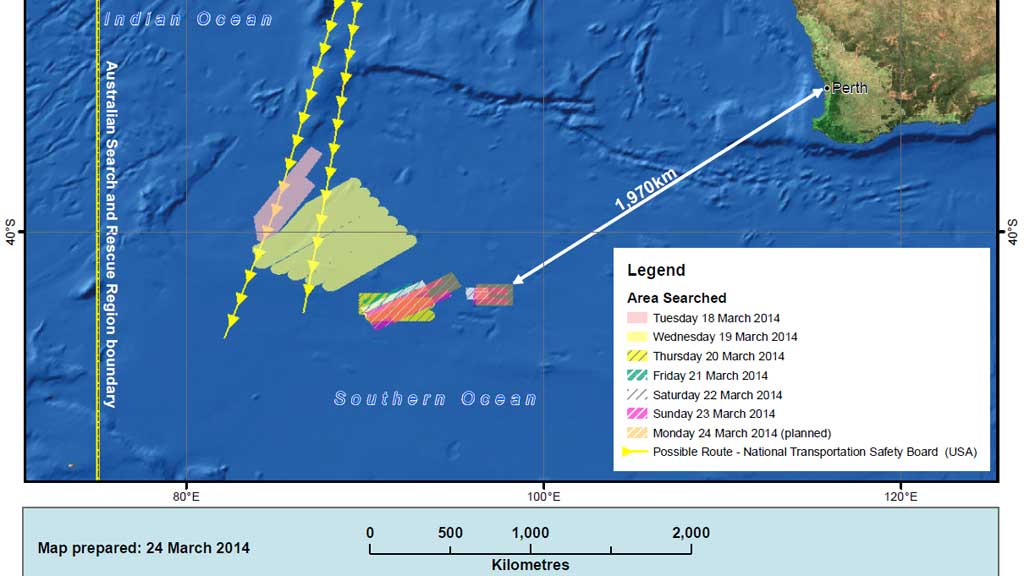Missing MH370: flight assumed crashed with ‘no survivors’
Malaysian Prime Minister Najib Razak says a plane missing for more than two weeks with 239 people on board is assumed to have crashed in the southern Indian Ocean west of Perth with no survivors.
Mr Razak said satellite analysis showed the plane’s last position was west of the Australian city of Perth.
Relatives of passengers and crew were informed of the “heartbreaking” news that flight MH370 ended in the southern Indian Ocean, he said.
The announcement was based on data from the UK Air Accidents Investigation Branch and tracking firm, Inmarsat, which had employed “a type of analysis never before used in an investigation of this sort”.
Mr Razak told a news conference in Kuala Lumpur that analysis by Inmarsat revealed that MH370’s last position was in the ocean west of Perth.
More from Channel 4 News: MH370's final location? Timeline and clickabe search map
“This is a remote location, far from any possible landing sites,” he said. “It is therefore with deep sadness and regret that I must inform you that according to this new data flight MH370 ended in the southern Indian Ocean.”
“For them (the relatives) the past few weeks have been heart-breaking. I know this news must be harder still.”

The latest map issued by the Australian Maritime Safety Authority, showing the areas searched and planned searches on Monday.
An Australian aircraft scouring the southern Indian Ocean for signs of the Malaysia Airlines jet spotted two new objects, Australian Prime Minister Tony Abbott said earlier on Monday.
He told parliament that two objects, one circular and greenish grey in colour and the second orange and rectangular, were spotted and that a naval vessel hoped to recover them soon.
A Chinese search aircraft also reported seeing several different “suspicious” white coloured objects, but a US navy aircraft has so far failed to find them.
The recent sightings follow reports by an Australian crew over the weekend of a floating wooden pallet and strapping belts in an area of the icy southern Indian Ocean that was identified after satellites recorded images of potential debris.
The search for the Boeing 777 which disappeared from radars on 8 March, shortly after taking off from Kuala Lumpur, is concentrated on an increasingly narrow stretch of rough sea in the southern Indian Ocean, thousands of miles from the plane’s original flight path.
Ten planes are taking part in the search in the southern corridor on Monday, including aircraft sent from China and Japan.
The biggest aviation mystery of all time – clickable map showing the search so far
China’s Ilyushin IL-76 aircraft spotted two “relatively big” floating objects and several smaller white ones dispersed over several kilometers, the Xinhua news agency said. The Australian Maritime Safety Authority (Amsa) said it would now use other aircraft scheduled to search the area on Monday to try and relocate the same objects.
China has also diverted its icebreaker Xuelong, or Snow Dragon, toward the location where the debris was spotted, Xinhua reported. A flotilla of other Chinese ships are also steadily making their way south. Over 150 of the passengers on board the missing plane were Chinese.
The missing flight MH370 vanished from civilian radar screens less than an hour after taking off from Kuala Lumpur for Beijing with 239 people on board on March 8. No confirmed sighting of the plane has been made since and experts are at a loss to explain what happened.

Photo: a mother writes a message to her son on a board dedicated to passengers on the missing MH370 at Lido Hotel, Beijing
Black boxes
The Chinese aircraft that spotted the objects was one of two IL-76s searching early on Monday. Another eight aircraft, from New Zealand, Australia, the United States and Japan, were scheduled to make flights throughout the day to the search site, some 2,500 km (1,550 miles) southwest of Perth.
The United States Navy is flying in its high-tech black box detector to the area, but initial searches didn’t recover any debris. The so-called black boxes record what happens on board planes in flight. At crash sites, finding the black boxes soon is crucial because the locator beacons they carry fade out after 30 days.
Commander Chris Budde, US Seventh Fleet Operations Officer, said: “If debris is found we will be able to respond as quickly as possible since the battery life of the black box’s pinger is limited.”
Commander Budde stressed that bringing in the black box detector, which is towed behind a vessel at slow speeds and can pick up “pings” from a black box to a maximum depth of 20,000 feet, was a precautionary measure.
‘It’s a lot of water to look for just perhaps a tiny object’
Aircraft flying on Monday were focused on searching by sight, rather than radar, because of the high seas and wind in the area which can affect the radar signals.
“It’s a lot of water to look for just perhaps a tiny object,” said Australia’s Deputy Prime Minister Warren Truss, before the reported sighting from Chinese aircraft. “Today we expect the weather to deteriorate and the forecast ahead is not that good, so it’s going to be a challenge, but we will stick at it.”
Australia was also analysing French radar images showing potential floating debris that were taken some 850 kms (530 miles) north of the current search area.